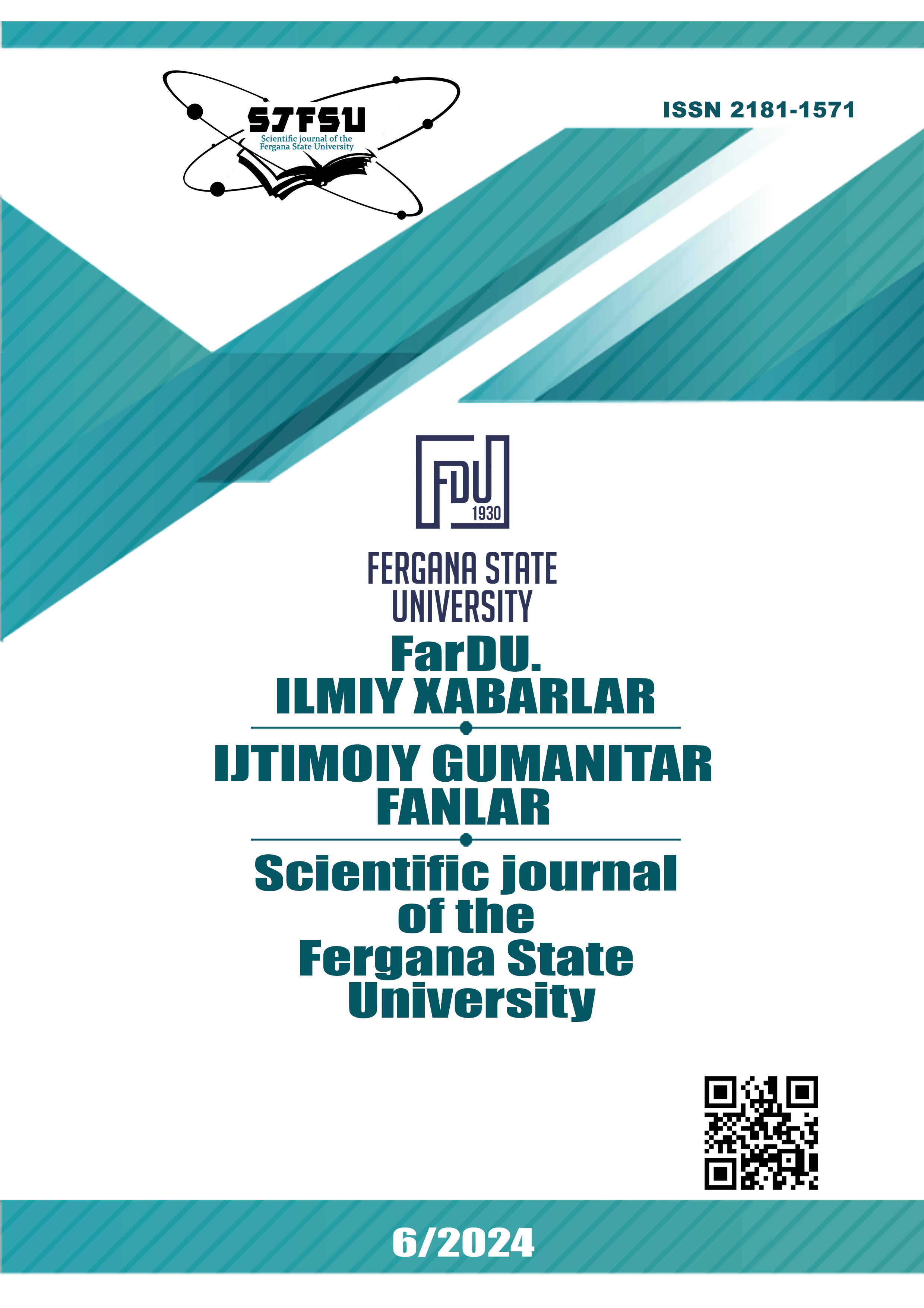THE EXPRESSION OF CULTURE, CUSTOMS AND FORMS OF ETIQUETTE BY USING NON-VERBAL MEANS IN SPEECH
Keywords:
non-verbal communication, paralinguistic means, non-verbal means, gestures, cross-cultural communication, national culture, customs, forms of etiquette.Abstract
This article examines the expression of national culture, customs, and forms of etiquette through nonverbal means in interpersonal communication in Uzbek, English, Turkish, and Russian languages. It explores speech culture, spirituality, and social behavior of people across these four languages. Customs and forms of etiquette associated with the use of nonverbal communication were classified into separate groups based on their conditions of application, purposes, interrelations, content, and social moral requirements. Furthermore, an analysis was conducted on nonverbal means reflecting the universally accepted language of communication, customs, values, or culture formed over centuries, considering the geographic location of the languages studied. The article also includes opinions of scholars emphasizing the significant role of the system of customs and national culture used in nonverbal communication in promoting these aspects on the global stage.
References
Дюма А. Три мушкетера. –М.: ЛитРес, 2015. − 680 стр. (Dumas A. Tri mushketera. M.: LitRes, 2015. − P. 680)
Николаева Т., Успенский Б. Языкознание и паралингвистика // Лингвистические исследования по общей и славянской типологии. −М.: Наука, 1966. − 63-74 стр. (T.Николаева, Б.Успенский. Языкознание и паралингвистика // Лингвистические исследования по общей и славянской типологии. − M.: Наука, 1966. − Стр. 63-74)
Пиз А. Язык телодвижений. −М.: Эксмо-през, 2010. − 258 стр. (Pease A. Yazik telodvijeniy. −M.: Eksmo-pres, 2010. −P. 258)
Питерский Я. Перспектива смерти. − Киев: ИП Стрельбицкого, 2015. − 320 стр. (Я Питерский. Перспектива смерти. −Kиев: ИП Стрельбицкого, 2015. − С. 320)
Садохин А. Введение в теорию межкультурной коммуникации. −М.: КноРус, 2014. − 254 стр. (Садохин А. Введение в теорию межкультурной коммуникации. −M.: KnoRus, 2014. − С. 254)
Ahmedov B. Amir Temur. –T.: Abdulla Qodiriy nomidagi xalq merosi nashriyoti, 1995. – 640 b.
Dikici A. Geleneklerin toplumdaki yeri ve önemi. Fitrat Üniversitesi Sosyal Bilimler Dergisi, 11 (2). ELAZIĞ, 2001. − S. 253.
Dostoevsky F. Crime and Punishment. Penguin Classics, 2002. – P. 634.
Dumas A. The Three Musketeers. Modern Library, 2001. − P. 625
Güntekin R. Çalikuşu. Istanbul, 2017. − S. 381
Nurmonov A. Tanlangan asarlar. 1-jild. −T.: Akademnashr, 2012. − 403 b.
Oйбек. Қутлуғ қон. Учинчи том. –T.: Ғофур Ғулом номидаги бадиий адабиёт нашриёти, 1969. − 390 б.
Poyatos F. Nonverbal Communication across Disciplines. Amsterdam /Philadelphia. John Benjamins B.V., 2002. − P. 474
Қодирий A. Ўткан кунлар. −T.: Ғофур Ғулом номидаги бадиий адабиёт нашриёти, 1974. – 494 б.
Saidxonov M. Aloqa-aralashuv va imo-ishoralar. −T.: Fan, 2008. − 83 b.
Stoker B. Drakula. Çeviren: Pinar Güncan − Istanbul: Bordo Siyah Yayinlari, 2018. − S. 624
Trimbur J. The Call to Write, Brief Fifth Edition. − Wadsworth, Cengage Learning. 2011. – P. 627.
Türklerin gelmiş geçmiş en eski gelenekleri//URL:www.yenisafak. com/foto-galeri/hayat/turklerin-gelmis-gecmis-en-eski-gelenekleri-2032725)
Warnke A. (Ne) zabitiye slavyanskiye obryadi i obichai // URL: culture.pl/ru/article/ nezabytye-slavyanskie-obryady-i-obychai
Downloads
Published
Issue
Section
License
Copyright (c) 2025 Scientific journal of the Fergana State University

This work is licensed under a Creative Commons Attribution-NonCommercial-NoDerivatives 4.0 International License.
How to Cite
Most read articles by the same author(s)
- Normuradov Muradulla Togaevich, Dovranov Kuvondik Turakulovich, Davranov Khuzhamkul Turakulovich, Davlatov Muzaffar Abduxamidovich, FTIR ANALYSIS OF SILICON AND OXIDE SILICON THIN FILMS , Scientific journal of the Fergana State University: No. 4 (2023): Scientific journal of the Fergana State University (Exact and natural sciences)
- , , BIOABSORPTION COEFFICIENT OF LAVENDER (LAVANDULA ANGUSTIFOLIA MILL) , Scientific journal of the Fergana State University: No. 3 (2024): FarDU.Ilmiy xabarlar jurnali. Ilova to'plam (Aniq va tabiiy fanlar)
- , , , , , METHODS FOR DETERMINING TERPENOIDS IN SOME REPRESENTATIVES OF PLANTS OF THE LABIATAE FAMILY , Scientific journal of the Fergana State University: No. 6 (2024): FarDU.Ilmiy xabarlar jurnali (Aniq va tabiiy fanlar)
- Obidov Muzaffar, Botirova Durdigul, Shoxnoza Zakirova, Dilfuza Egamberdieva, BIOLOGICAL CONTROL OF COTTON DISEASE BY BACTERIAL AGENTS , Scientific journal of the Fergana State University: No. 3 (2024): FarDU.Ilmiy xabarlar jurnali. Ilova to'plam (Aniq va tabiiy fanlar)
- Khoshimov Muzaffar Ganijanovich, PROBLEMS OF GENERAL AND TYPOLOGICAL THEORY OF COMPOSITE SENTENCE WITH A PARENTHETICAL CLAUSE AS AN INVARIANT TYPE OF SYNTACTIC UNIT (to the statement of question of parenthetical introductory and insertive clauses) , Scientific journal of the Fergana State University: No. 1 (2024): Scientific journal of the Fergana State University (Social humanities sciences)
- , BIOGEOCHEMISTRY OF ELEMENTS IN LIGHT SIEROZEMS , Scientific journal of the Fergana State University: No. 3 (2024): FarDU.Ilmiy xabarlar jurnali. Ilova to'plam (Aniq va tabiiy fanlar)
- , , METHODS OF ADMINISTRATION OF ANTIHELMINT PREPARATIONS AGAINST HELMINTHOUS DISEASES OF FISH , Scientific journal of the Fergana State University: No. 3 (2023): FarDU ilmiy xabarlari jurnali (Aniq va tabiiy fanlar)
- Shokirov Muzaffar Turobjon o‘g‘li, Xaitbayev Alisher Xamidovich, Toshov Hamza Sayidmurodovich, Yuldashev Iqboljon Shukuraliyevich, Turg‘unboyev Shavkatjon Shuhratjon o‘g‘li, THE LUPININE MOLECULE: A JOURNEY INTO ITS CRYSTALLOGRAPHIC STRUCTURE , Scientific journal of the Fergana State University: No. 3 (2024): FarDU.Ilmiy xabarlar jurnali. Ilova to'plam (Aniq va tabiiy fanlar)
- , SYLYBUM MARIANUM (L.) GAERTN. CHEMICAL COMPOSITION AND SIGNIFICANCE OF THE PLANT , Scientific journal of the Fergana State University: No. 3 (2024): FarDU.Ilmiy xabarlar jurnali. Ilova to'plam (Aniq va tabiiy fanlar)
- , INFORMATION ON THE IMPORTANCE AND CULTIVATION TECHNOLOGY OF ECHINACEA PURPUREA (L.) MOENCH , Scientific journal of the Fergana State University: No. 3 (2024): FarDU.Ilmiy xabarlar jurnali. Ilova to'plam (Aniq va tabiiy fanlar)

